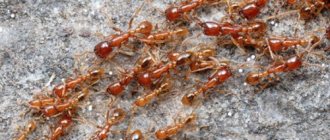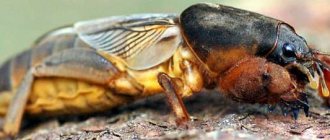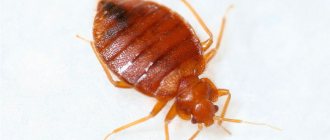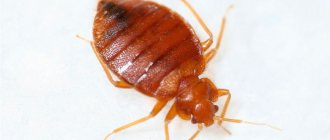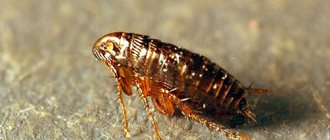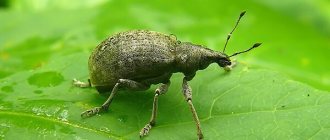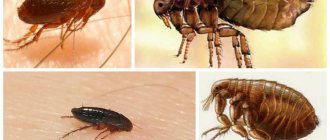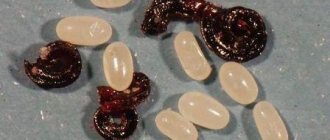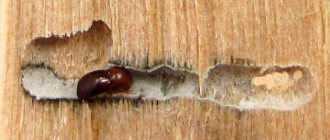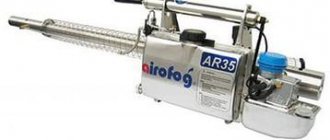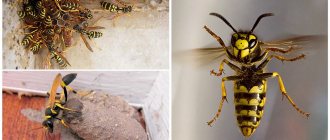Wasps have become habitual companions of humans. They can be found in the city and at their summer cottage. During the day they habitually circle over fruits and flowers, and in the evening they fly to the nest. Its location depends on the preferences of the queen, some build it in trees, others in attics, and still others in empty birdhouses. Numerous families of burrowing, road and sand wasps have adapted to breeding in burrows. These are solitary insects that dig their homes on their own. Paper wasps or hornets may make their home under the soil. Ground wasps are not a separate family, but different species that choose soil to build a nest.
Description of the ground wasp
Depending on the species, an adult wasp grows up to 1–10 cm. Females are most often 1–2 cm larger than males and worker wasps. The body of insects consists of a body, tapering towards the end, and a head and chest connected by a thin bridge. It is either covered with small hairs or there is no pubescence at all.
In addition to the traditional black and yellow color, the body of insects can be black or dark brown with white, red, orange stripes and spots. Bright stripes are found not only on the body, but also on the head and legs.
Ground wasps have 2 pairs of membranous thin wings. They are transparent, colorless or with a blue, black, red or brown tint. There are a pair of antennae on the head of different shapes and lengths. They are like antennas that pick up sounds and smells.
The paws consist of 5 segments. With their help, insects move and grab prey. Unlike ordinary wasps, on the front legs of species that independently dig holes in the ground, there is a row of hard bristles, similar to a comb. They help them push back the soil.
Wasps have good vision due to their large compound eyes. Insects do not have teeth, but have powerful jaws that easily bite through the dense covering of the victim.
A needle sting is hidden at the bottom of the abdomen of females. It is connected to the gland that contains the poison. Females use the sting to hunt prey and for defense and protection of the nest.
Precautionary measures
Having decided how to get rid of earthen wasps, you need to take care of your own protection. You should be careful while working, because a disturbed swarm can severely bite a person. Recommended safety measures include:
- Wear protective suit. The best option is beekeeper's clothing, but casual clothing is also suitable. It should be sewn from thick fabric. Long sleeves, a cap on your head and a net on your face are required. Put gloves on your hands.
- While working, do not make noise or make sudden movements. These actions provoke an attack by insects.
- You should take care of shelter in advance in case of an attack. If a residential building is built close to the nest, it is worth closing all the windows.
- It is better to destroy earthen wasps in the evening. At this time of day they gather in the nest and prepare for sleep. You can catch the entire swarm in one place and with minimal activity.
In a situation where the insect nest is located in a remote corner and does not pose a serious danger, it is better not to disturb it. In the fall, its inhabitants will scatter and die.
Kinds
Sand (burrowing) wasps
This is a group of solitary predatory wasps 2–5.5 mm long. Insects have a small head, straight antennae and long legs. The color of most representatives is black with a red stripe or spots on the abdomen. There are black species with yellow or white stripes. The pronotum of all sand wasps resembles a roller. The most famous burrowing species are: Larra anathema wasp, Ammophila wasp, Philanthus .
Road wasps
Insects with an elongated black body 1.5–4 cm and long curled antennae. There are red or yellow spots on the abdomen. The wings of road wasps are darkened: black, black-blue or brown. Road wasps are active and constantly moving in search of prey.
German wasps
They are similar in appearance to the common wasp, but smaller in size. The body of an adult is 12–15 mm in length. The tip of the abdomen of this insect is not black, but yellow. The colony size is smaller than that of the common wasp.
Floral
Small insects no more than 1 cm in length with a black and yellow abdomen. In the ground, queens most often build single nests from a mixture of clay, sand, moistened with saliva.
Scolia
Representatives of this family are solitary wasps. Depending on the species, insects grow up to 1–10 cm. The body of many scolias is densely covered with hairs. The color is black with yellow, white, red stripes and spots.
How dangerous are these insects for humans?
The main problem with dealing with wasps is their painful stings.
Moreover, it doesn’t matter which family member bites you: one that has a nest in the ground or in the crown of branches. In any case, in the place where you were stung, redness and swelling will appear, which will be accompanied by painful sensations, eventually turning into itching
After a few days, everything will go away on its own, but only if you are not susceptible to the poison.
For people suffering from allergic diseases, encountering wasps is fraught with more serious consequences. They may develop a rash all over their body, a rise in temperature and a deterioration in the general condition of the body.
The photo shows swelling of the hand from a wasp sting
So, despite the great benefits that these insects bring to the garden, it is necessary to fight them. However, if the nest is in a place that you rarely visit and quite far from home, then you may decide to leave everything as it is.
Features of life
building nests in the spring at the first warming. Some species settle in sandy soil, while others choose dense soil. Females choose a suitable place.
The wasp digs the ground for its burrow with its paws, which it uses to push the soil away like a shovel. Powerful jaws are involved in the work, and wings help break through dense layers. The insect continuously waves them, the air enters special bags on the chest. The muscles contract, and air is pushed from the sacs through special channels to the jaws. They begin to work with such frequency that a depression is formed with a slight touch to the ground.
Insects can settle in a hole abandoned by rodents, in voids under the soil, near roots and dried trees, in an old anthill.
In the underground dwelling, females build honeycombs in the same way as outside. Chewed wood fibers and saliva produce a mass that, when hardened, looks like paper. eggs in them . After 1–1.5 months, larvae . The female takes care of them, brings protein food to each cell, and she herself feeds on flower nectar. When the larvae turn into adult insects, they are involved in the construction of a nest for new family members, searching for food, guarding and protecting the home.
By the end of summer, the colony of social wasps reaches its maximum size and numbers several thousand worker wasps and heterosexual individuals ready for procreation. Only fertilized young females overwinter ; the remaining members of the colony die.
Solitary species of ground wasps live separately, building small nests or occupying soil voids for reproduction. The female catches a small insect: a spider, a caterpillar, a fly and paralyzes the victim with poison. It lays an egg on its body and hides its prey in a hole. It will be food for the emerging larva, since the wasp does not care for the offspring. She immediately leaves the dungeon and seals the entrance. Young wasps that have grown from larvae emerge independently in the spring.
What damage do ground wasps cause?
Ground wasps, like their relatives living in outdoor nests, are aggressive and sting painfully . Insects love to settle in light and loose soil in garden beds, elevated flower beds and alpine hills, under the roots of berry bushes. Meeting them will be an unpleasant surprise during the harvest. Ground wasps will definitely take revenge for an attempt on their territory.
Neighborhood with wasps is undesirable and dangerous if there are allergy sufferers and small children in the family.
Wasps are sensitive to strong odors. They flock to the smell of sweet fruits, drinks, meat, fish and can be very annoying. They spoil fruits and berries on trees and shrubs .
Insects look for sweet food in garbage dumps and compost heaps, and then bring and leave putrefactive bacteria on the table, dishes, and food in the house .
If there are beehives on the property or in the neighborhood, then predatory wasps will kill the bees .
Behavior, lifestyle
By mid-summer, a wasp swarm numbers hundreds of thousands of adults. Each wasp performs its own functions:
- some build a nest;
- others forage for food;
- still others look after the larvae.
At the head is the uterus, which is exclusively engaged in the reproduction of offspring. Adults feed on flower nectar, fruit and vegetable juices, and honey. The larvae require protein food to feed them. For their sake, working females kill insects and circle around meat and fish products.
Ground wasps on the site become extremely active towards the end of summer and beginning of autumn. They often enter the house, circle in the yard, and do not allow them to work in peace in the garden. Insects are aggressive, the slightest movement of the hand in their direction is regarded as a threat, and they rush to attack. Accidentally finding a person near a nest can result in numerous bites from an entire swarm.
Interesting!
Ground wasps communicate with each other by making special sounds and signals. The insect notifies others about danger, threat, and the presence of food. In a matter of minutes, a whole swarm appears.
How to get rid of earth wasps
Lures and traps
The bait is prepared by mixing sweet syrup, jam diluted with water, fermented kvass or beer with an insecticide without a pungent odor. The bait is poured into a saucer and placed next to the hole. Adult insects taste the poison and die. Over the course of 2 weeks, fresh solution is added to the saucer to destroy as many pests as possible.
The bait is poured into a wasp trap made from a plastic bottle. The top part is cut off, turned over and inserted with the neck down inside the other part of the bottle. The walls are secured with tape or staples.
Instead of liquid bait, a piece of meat, fish, or fruit treated with an insecticide is placed in the trap. Solid poison can be immediately placed in wasp holes.
Traditional methods
Instead of chemicals, boric acid is added to the bait: 10 g of powder per 1 liter of sweet base.
Wasp holes and clusters of insects are poured with boiling water, and crawling wasps are destroyed. Before treatment, protect the body from bites with thick clothing.
Insects are sprayed with a soap solution. It sticks to the body, preventing them from flying and breathing.
Chemical and biological drugs
Doctor Klaus from OS
The insecticide contains the poison alpha-cypermethrin. It is sold in plastic containers with a removable, reusable injector. The drug can be sprayed from a bottle or connected to a hose and poured poison into the wasp's nest.
Mosquitoll from wasp nests
The product is in a high-pressure cylinder and is used for spraying. A powerful jet of the drug reaches wasps at a distance of up to 6 m. This will allow you to safely get rid of insects.
Similar aerosol insecticides are Diflofos Neo, Super Cobra, Raptor, Bros, Clean House, Universal Kombat .
Get
A modern drug based on chlorpyrifos with a prolonged effect of up to 6 months.
Used as an additive in bait and for treating wasp nests. 100 ml of insecticide is poured into 1 liter of a sweet solution of water with jam or fermented kvass or beer. It does not have a strong odor, so it will not repel pests.
To destroy a nest, the consumption rate of the drug is 100 ml per 2 liters of water. Prepare the required amount of solution and pour it into the wasp hole or spray it.
Danger to people
Being close to predatory insects can be beneficial. Wasps that have settled on the site will help with the destruction of pests. Over the summer they will catch hundreds of flies, caterpillars, and butterflies for their offspring. All the positives are outweighed by the harm done in a few cases. Why are ground wasps dangerous?
- If there are allergy sufferers in the family, a bite can provoke a dangerous immune reaction in the body.
- The proximity of insects is undesirable for small children.
- The nest is located in the garden bed and interferes with harvesting.
- The proximity of wasps next to the apiary is unacceptable. Predators will kill bees.
Insecticides
Modern chemicals can get rid of any insects. Enteric insecticides can be poured into the nest or mixed with bait. In the first case, you need to prepare the solution according to the instructions and pour it into the tap hole. The top of the nest is closed with a weight that prevents the wasps from flying out. The product in powder or granules can be scattered at the entrance. Insects will catch it on their paws and carry it inside, poisoning the larvae.
Making poisonous baits is a simple and safe way to combat ground wasps. The insecticide is mixed into sweet syrup or liquid honey. The container with the bait is left near the hole. Insects will not pass by the treat. With food, the poison enters the body of adults, and sticky drops from the paws will poison the larvae. Boric acid is suitable as a toxin. As the bait is eaten, syrup with insecticide is added. After one or two weeks, all the inhabitants of the nest will be dead. The following drugs are used:
- Karbofos - the product is sold in the form of powder and concentrate. Due to its pungent odor, it should not be used for traps.
- Aktara is a universal insecticide against harmful insects. The granules can be scattered on the ground, and the powder can be used for bait.
- Moskitol - thanks to the aerosol form, you do not need to go close to the nest. The spray from the can has a range of 6 m. The poisons cypermethrin and bioallethrin instantly paralyze insects.,
- Gett - a solution of the drug leads to disruption of the nervous activity of wasps. The product has a long shelf life.
Methods of controlling ground wasps using insecticides are safe and effective
But you should be careful around the nest
Fire is a formidable ally in the fight against insects. Burning a nest is a simple and effective method. Paper honeycombs burn well, especially after pouring kerosene or gasoline. Several liters of flammable liquid will be required. A small path is made near the hole for ignition. After bringing a match, it is better to run away, as there may be a small explosion and a burst of flame. The method is not recommended if there are flammable buildings nearby.
One of the mechanical ways to destroy stinging insects is to pour boiling water over their home. The method is absolutely inexpensive, but is inferior in efficiency to the use of chemicals. It will be an alternative to burning. Hot water will need about 20 liters. Boiling water is quickly poured into the hole, which is closed with a stone. The disadvantage of this method is that not all insects will die after contact with water. The procedure will have to be repeated
Be careful when working with boiling water to avoid getting burned.
How to get rid of a wasp's nest
- Having discovered a wasp hole in the ground, it is poured with boiling water. In the evening, when the adults return home, the passages are filled with hot water and the hole is completely covered with stones. The next day the treatment is repeated to get rid of the remaining insects. Underground honeycombs are removed from the soil and destroyed, and the voids are filled with earth. This serious procedure is carried out in protective clothing.
- The wasp's nest is destroyed by fire. Flammable liquid and oily substances are poured into the passages and set on fire. Most underground inhabitants will die, but this method is controversial and unsafe. Not every gardener will decide to use it in their beds, flower beds, near trees and shrubs.
- Ground wasps can be smoked out of their nest. A fire is made or a piece of rubber is set on fire next to the wasp’s dwelling. Acrid smoke will cause earth wasps to leave the hive.
Use of traps and baits
Traps have become widespread due to the ease and safety of getting rid of striped insects. A fairly effective remedy for wasps is temporary. After all, there is no guarantee that all representatives of the swarm will fly into the traps. Besides, the next generation is likely already waiting in the wings in the remaining hornet's nest.
However, if you can't find the source of the threat, distracting them is also a good option. Especially when you are planning a picnic on the street or children are running around the yard.
You can find ready-made traps on sale, but it won’t be difficult to remove wasps from the house with your own hands.
The main thing is to know what will definitely attract their attention and act as bait. These are aromatic fruits and berries. Products “under the temperature” work great: fermented jam, compote, beer, wine
Wasps fly to fresh meat and fish
Products that are “under the temperature” work great: fermented jam, compote, beer, wine. Wasps fly to fresh meat and fish.
Usually the trap is a transparent container with attractants - baits that distract wasps from people. It’s easy to fly into it, but impossible to get out. The simplest one is easily made from an ordinary plastic bottle. For this:
- Cut off the upper cone-shaped part.
- Bait is poured into the bottle to a third of its volume.
- Remove the lid from the cut cone.
- Insert it back with the neck inward.
- They are installed near the swarming site and hung on trees.
Wasps, flying inside, will not get out and will die, drowning at the bottom. To speed up the process, boric acid or some poisonous drug is added to the attractant.
If you don't have a bottle on hand, you can use leftover fruit or berries in another way. Watermelons and aromatic melons work especially well. They are cut into pieces, doused with odorless poison and left on the street.
You can also buy special poisoned baits that wasps carry to the nest: when they die, they poison the swarm.
What to do if bitten by a ground wasp
The sting of the ground wasp is painful, reminiscent of the pain of a burn . The affected area on the skin becomes red and swollen. The most dangerous insect bites are on the face, tongue, and neck . A severe allergy may suddenly develop and the person will need medical attention.
Simple actions will ease the victim’s condition:
- the bite site is washed with cold water and treated with lemon juice, vinegar, parsley decoction, or a fresh plantain leaf is applied;
- apply a cold compress to the swelling and give the victim an antihistamine to drink;
- after a bite, drink more liquid: water, tea, sour drinks.
Avoid alcohol for 2 days; it can increase swelling. During this period, the condition of the victim is closely monitored. If inflammation intensifies and is accompanied by fever, suffocation, and dizziness, you should immediately go to the hospital.
